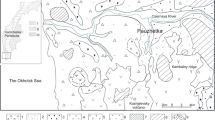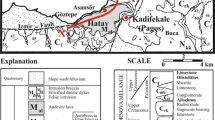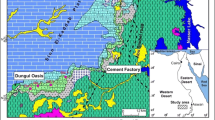Abstract
The Meymand world heritage site (Kerman Province, Iran) is a rock-hewn village carved within a pyroclastic rock mass, Meymand Tuff. This site, having an ancient local population with an age of 2000 years, is hosted by a weak rock exposed to deterioration and weathering processes. However, our understanding of the characteristics of the Meymand Tuff is limited to some previous general studies. Therefore, in the present study, the stratigraphy and intrinsic characteristics of the Meymand tuff are investigated to determine its weathering behavior and durability. For this purpose, comprehensive field and laboratory investigations were carried out. The stratigraphy of the valley and the pyroclastic flows that had deposited the Meymand tuff were identified and outlined based on field investigations and many surveyed sections along the Meymand valley. Next, the mineralogical composition, texture, structure, physical and mechanical properties, water absorption rate, slake durability, wetting–drying durability, shrinkage potential of the fine portion, and collapse potential of the Meymand tuff were assessed through laboratory investigations. The results revealed that two pyroclastic flows had deposited the host tuff rocks of the Meymand site. These rocks have a heterogeneous texture comprising very coarse-grained clasts to the fine-grained matrix. Rock characteristics including heterogeneous texture, high porous and open structure, clay-rich mineralogical composition, high water absorption capacity, and swelling and shrinkage potential of the fine portion of the matrix have resulted in adverse behaviors in Meymand tuff. These behaviors are pertained to the strength softening, weight loss, and deterioration at wetting drying cycles.





















Similar content being viewed by others
References
Ahmadipour H (1994) Dynamism of volcanic activities in Mosahim volcano (Shahre-Babak). MSc thesis, Department of Geology, Shahid Bahonar Univerity, Kerman, Iran
Anania L, Badalà A, Barone G, Maria Belfiore C, Calabrò C, La Russac M, Mazzoleni P, Pezzino A (2012) The stones in monumental masonry buildings of the ‘“Val di Noto”’ area: new data on the relationships between petrographic characters and physical–mechanical properties. Constr Build Mater 33:22–132
ASTM D4644–16 (2016) Standard test method for slake durability of shales and other similar weak rocks. ASTM International, West Conshohocken
ASTM (2009) Annual book of ASTM Standards, vol. 04.08, 04.09, ASTM International, West Conshohocken
BS 1377–3 (2018) Methods of test for soils for civil engineering purposes. In: Chemical and electro-chemical testing, British Standards Institution, UK
Cecconi M, Scarapazzi M, Viggiani GMB (2010) On the geology and the geotechnical properties of pyroclastic flow deposits of the ColliAlbani. Bull Eng Geol Environ 69:185–206
Cherblanc F, Berthonneau J, Bromblet P, Huon V (2016) Influence of water content on the mechanical behaviour of limestone: role of the clay minerals content. Rock Mec Rock Eng 49(6):2033–2042
Colella A, Benedetto C, Calcaterra D, Cappelletti P (2017) The neapolitan yellow tuff: an outstanding example of heterogeneity. Constr Build Mater 136:361–373
De Kock T, Turmel A, Fronteau G, Cnudde V (2017) Rock fabric heterogeneity and its influence on the petrophysical properties of a building limestone: lede stone (Belgium) as an example. Eng Geol 216:31–41
Elif A, Ulusay R, Aydan O, Mahmut M (2015) On the difficulties of geotechnical sampling and practical estimates of the strength of a weakly bonded volcanic soil. Bull Eng Geol Environ 74:1375–1394
Elif A, Ulusay R, Mahmut M (2015) An experimental investigation of the mechanical behavior and microstructural features of a volcanic soil (Isparta, Turkey) and stability of cut slopes in this soil. Eng Geol 189:68–83
Fitzner B, Heinrichs K (2001) Damage diagnosis at stone monuments-weathering forms, damage categories and damage indices. In: Prikryl R, Viles HA (eds) Understanding and managing stone decay, Proceeding of the International Conference “Stone Weathering and Atmospheric Pollution Network (SWAPNET 2001)”, Prachov Rocks, pp 11–56.
Fitzner B, Heinrichs K, Kownatzki R (1997) Weathering forms at natural stone monuments—classification, mapping and evaluation. Int J Restor Build Monum 3(2):105–124
Fredlund DG, Rahardjo H, Fredlund MD (2012) Unsaturated soil mechanics in engineering practice. Wiley, New York. https://doi.org/10.1002/9781118280492
Germinario L, Torok A (2019) Variability of technical properties and durability in volcanic tuffs from thesame quarry region—examples from Northern Hungary. Eng Geol 262:105319
Germinario L, Siegesmund S, Maritan K, Mazzoli C (2017) Petrophysical and mechanical properties of Euganean trachyte and implications for dimension stone decay and durability performance. Environ Earth Sci 76:739
Gillespie MR, Styles MLT (1999) Classification of igneous rocks. British Geological Survey Research Report RR 99–06. BGS Rock Classification Scheme, vol 1
Hashemi M, Khabbazi A, Banikheir M (2018) Engineering geological and geoenvironmental evaluation of UNESCO World Heritage Site of Meymand rock-hewn village. Envorin Earth Sci 77:3
Hassanzadeh J (1993) Metallogenic and tectonomagmatic events in the SE sector of the cenozoic active continental margin of centeral Iran (shahrbabk area, kerman province). Ph.D thesis, University of California, Los Angeles.
Hawkins A (1998) Aspects of rock strength. Bull Eng Geol Env 57(1):17–30
Heap M, Farquharson J, Kushnir A, Lavallée Y, Baud P, Gilg H, Reuschlé T (2018) The influence of water on the strength of Neapolitan Yellow Tuff, the most widely used building stone in Naples (Italy). Bull Volcanol 80:51
Kanji MA (2014) Critical issues in soft rocks. J Rock Mech Geotech Eng 6:186–195
Kuang X, Jiao J, Li H (2013) Review on airflow in unsaturated zones induced by natural forcings. Water Resour Res 49:6137–6165
IAEG (1979) Classification of rocks and soils for engineering geological mapping .Part 1: rock and soil materials. Bull Eng Geol Environ 19:355–371
ICHHTO (Islamic Republic of Iran Iranian Cultural Heritage, Handicrafts and Tourism Organization) (2012) Nomination of the cultural landscape of Maymand for inscription on the world heritage list, executive summary. UNESCO world heritage convention, Tehran
ISRM (2007) The complete ISRM suggested methods for rock characterization, testing and monitoring: 1974–2006. In: Ulusay R, Hudson JA (eds) Suggested methods prepared by the commission on testing methods, international society for rock mechanics, compilation arranged by the ISRM Turkish National Group, Ankara
Li L, Tan Y, Huang B, Deng X (2020) Pore property as an indicator of macro-deterioration in slightly weathered tuffs. Eng Geol 267:105492
López-Doncel R, Wedekind W, Dohrmann R, Siegesmund S (2013) Moisture expansion associated to secondary porosity: an example of the Loseros Tuff of Guanajuato, Mexico. Envorin Earth Sci 69:1189–1201
Ng Lu, Zhang C (2019) Soil sorptive potential: concept, theory, and verification. J Geotech Geoenviron Eng 145(4):04019006
Martínez-Martínez J, Benavente D, Gomez-Heras M, Marco-Castaño L, García-del-Cura MA (2013) Non-linear decay of building stones during freeze–thaw weathering processes. Constr Build Mater 38:443–454
Martínez-Martínez J, Corbí H, Martin-zojas I, Baeza-Carratalá JF, Giannetti A (2017) Stratigraphy, petrophysical characterization and 3D geological modelling of the historical quarry of Nueva Tabarca island (western Mediterranean): Implications on heritage conservation. Eng Geol 231:88–99
Martínez-Martínez J, Pola A, García-Sánchez L, Reyes Agustin G, Osorio Ocampo LS, Macías Vázquez J, Robles Camacho J (2018) Building stones used in the architectural heritage of Morelia (México): quarries location, rock durability and stone compatibility in the monument. Envorin Earth Sci 77:167
Moeinzadeh H, Bahrambeygi b (2018) Quantitative comparison of structural and alteration genesis relations of Masahim and Bidkhan-volcano calderas: Located in northern strip of Dehej-Sardu'ieh, Kerman, Iran. Egyptian Journal of Remote Sensing and Space Science. DOI: https://doi.org/10.1016/j.ejrs.2018.08.001
Molina E, Benavente D, Sebastian E, Cultronea G (2015) The influence of rock fabric in the durability of two sandstones used in the Andalusian Architectural Heritage (Montoro and Ronda, Spain). Eng Geol 197:67–81
Molina E, Cultrone G, Sebastian E, Alonso FJ, Carrizo L, Gisbert J, Buj O (2011) The pore system of sedimentary rocks as a key factor in the durability of building materials. Eng Geol 118:110–121
Potro RL, Hürlimann M (2008) Geotechnical classification and characterization of materials for stability analyses of large volcanic slopes. Eng Geol 98:1–17
Potzel C, Dohrmann R, Siegesmund S (2018) Clay swelling mechanism in tuf stones: an example of the Hilbersdorf Tuf from Chemnitz. Germany Envorin Earth Sci 77:188
Ruedrich J, Kirchner D, Siegesmund S (2011a) Physical weathering of building stones induced by freeze–thaw action: a laboratory long-term study. Environ Earth Sci 63:1573–1586
Ruedrich J, Bartelsen T, Dohrmann R, Siegesmund S (2011b) Moisture expansion as a deterioration factor for sandstone used in building. Environ Earth Sci 63:1545–1564
Shahrbabaky A (1997), Geochemistry, geochornology and petrography of feldspathoid - bearing rocks in the Urumieh–Dokhtar volcanic belt, Iran, Ph.D thesis, University of Wollongong. School of Geosciences, University of Wollongong.
Simons DB, Richardson EV (1966) Resistance to Flow in Alluvial Channels, United States department of the interior stewart l. udall, Secretary geological survey William T. Pecora, Director.
Tayebi M, Hashemi Tangestani M, Vincent R (2014) Alteration mineral mapping with ASTER data by integration of coded spectral ratio imaging and SOM neural network model. Turkish J Earth Sci 23:627–644
Vazquez P, Alonso FJ, Carrizo L, Molina E, Cultrone G, Blanco M, Zamora I (2013) Evaluation of the petrophysical properties of sedimentary building stones in order to establish quality criteria. Constr Build Mater 41:868–878
Viles HA, Camuffo D, Fitz S, Fitzner B, Lindquist O, Livingston RA, Maravellaki PV, Sabbioni C, Warscheid T (1997) Group report: what is the state of our knowledge of the mechanisms of deterioration and how good are our estimates of rates of deterioration. In: Baer NS, Snethlage R (eds) Report of the Dahlem Workshop on “Saving our architectural heritage: the conservation of historic structures”, Berlin.
Wedekind W, López-Doncel R, Dohrmann R, Kocher M, Siegesmund S (2013) Weathering of volcanic tuff rocks caused by moisture expansion. Environ Earth Sci 69:1203–1224
Yavuz AB (2012) Durability assessment of the Alactituf (Izmir) in western Turkey. Environ Earth Sci 67:1909–1925
Yusefi I, (1996) Petrographic, geochemical and genesis of Meymand pyroclastics sediments, Ms. Thesis, University of Kerman, Kerman Province, Iran, pp 108–127
Acknowledgements
The authors would like to acknowledge the funding received by a grant from Iran National Science Foundation (INSF) (98001268) for this study. The authors would also like to thank the anonymous reviewers whose comments and suggestions have greatly improved this paper.
Funding
This study was funded by a grant from Iran National Science Foundation (INSF) (98001268).
Author information
Authors and Affiliations
Corresponding author
Ethics declarations
Conflict of interest
The authors declare that they have no conflict of interest.
Additional information
Publisher's Note
Springer Nature remains neutral with regard to jurisdictional claims in published maps and institutional affiliations.
Rights and permissions
About this article
Cite this article
Kiani, M., Hashemi, M., Ajalloeian, R. et al. Investigating the geological and geomechanical characteristics governing the weathering behavior of Meymand tuff. Environ Earth Sci 81, 45 (2022). https://doi.org/10.1007/s12665-022-10169-3
Received:
Accepted:
Published:
DOI: https://doi.org/10.1007/s12665-022-10169-3




